How to Disable or Delete Samsung Pay App
Technology has enabled us to pay much more conveniently over the years. The development of features that enable us to use our phones as credit cards ensures that mobile payment is getting increasingly popular – with Samsung Pay at the forefront. After all, you might forget your wallet, but you’ll never leave the house without your phone.
But since the technology is young, the software doesn’t have the reliability Samsung users would have hoped for. Aside from the fact that it doesn’t even come close to supporting all banks, let’s all admit that NFC is still incredibly easy to hack. Aside from security concerns, Samsung Pay has some habits that make it less desirable – like removing your CC and making you reauthorize every couple of days.
As with all things related to technology, some people love it and some people don’t. If you’re in the last category, you’ve come to the right place. Since Samsung Pay is one of those apps forced by Samsung on your device (bloatware), uninstalling it completely will require you to root your device.
But don’t get discouraged, if root isn’t an option there are still ways to remove its functionality and prevent it from using your phone resources.
With this in mind, here’s a list of methods for getting rid of Samsung Pay.
Method 1: Disabling it from App manager
This method will only work if you have root access or you don’t have the latest OS update. Keep in mind that disabling Samsung Pay will remove any of its functionality and stop it from using system resources, but it will still remain on your system.
- Tap the menu button and go to Settings > Apps (Applications) and tap on Application Manager.
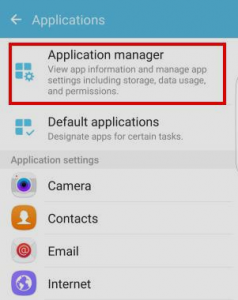
Note: On some older models, the Application Manager entry will be inside the More tab (located in the top right section of the screen). - Scroll down through the list and tap on Samsung Pay.
- Tap on Disable and confirm. If the disable button is grayed out, you need to follow one of the other methods below.

Method 2: Deleting Samsung Pay with Titanium Backup (Root Required)
As the title suggests, this method will require you to have root access on your device. If you’re unsure whether you have root or not, there’s a simple way to check if your device is rooted. Install the Root Checker app from Google Play Store and see if your device has root access.
 If you have root access, you will be able to completely remove Samsung Pay. To do so, we are going to use Titanium Backup – the most popular app used by the rooting community capable of utilizing root access to remove or modify system-level files.
If you have root access, you will be able to completely remove Samsung Pay. To do so, we are going to use Titanium Backup – the most popular app used by the rooting community capable of utilizing root access to remove or modify system-level files.
Warning: While deleting Samsung Pay using Titanium Backup is confirmed to work without affecting other functions of your device, deleting other preloaded apps or services might affect critical processes needed for your device to function properly – in some extreme cases you might even brick your device. Please do exercise caution when using this app and always get informed before deciding on removing a system app.
- Download and install Titanium Backup from Google Play Store.
- From the list of apps, tap on Samsung Pay.
- Tap on Un-install! and confirm.
 Note: You can also opt to Freeze the app. This is the equivalent of disabling the app, as shown in method 1.
Note: You can also opt to Freeze the app. This is the equivalent of disabling the app, as shown in method 1. - Wait for the process to complete.
Method 3: Disabling Samsung Pay with Package Disabler Pro (Paid)
If you don’t have root access and you’ve updated to the latest Android versions, you can still disable Samsung Pay, but it will require you to buy Package Disabler Pro. Until several months ago they also had a free version, but Samsung legally forced them to remove it.
Now it costs a little more than $1, so it certainly won’t hurt your finances too much. If you decide to buy it, make sure you buy the Samsung version of the app otherwise it won’t work. Here’s a quick guide:
- Download and install Package Disabler Pro (Samsung) from Google Play Store.
- When you first open the app, you’ll be asked to provide administrator rights. Do so by hitting Activate and then Confirm.
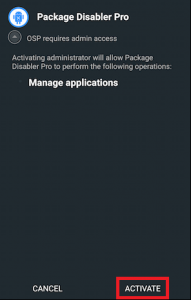
- Now that you’re in the app, you should see a list of packages and their names. Scroll down until you find Samsung Pay simply tap on the checkbox next to it to disable. Repeat the procedure with Samsung Pay Framework.

- Confirm that it’s disabled by seeing if Samsung Pay is gone from your App drawer.
Method 4: Revoking Permissions for Samsung Pay
If you’re not prepared to spend a buck to disable it with ease, you can also go through extra trouble to prevent Samsung Pay from running. Unfortunately, it won’t be as effective as disabling or removing it completely. Here’s how:
- Go to Settings > Apps(Applications) > Application Manager, tap on Samsung Pay and Force Stop it. Repeat the procedure with Samsung Pay Stub.
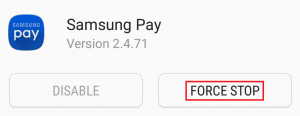
- After force stopping both, scroll down and tap on Permissions.
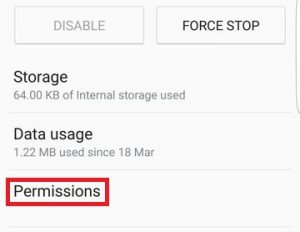
- Revoke every permission for both Samsung Pay and Samsung Pay Stub.
- Open Google Play Store and swipe from left to right. Tap on My apps & games.
- Scroll down and tap on Samsung Pay. Untick Auto-update by tapping the three-dot icon in the top-right corner.
- Go back to the Samsung Pay entry in Settings > Apps(Applications) > Application Manager and clear both data and cache. Repeat the procedure with Samsung Pay Stub.
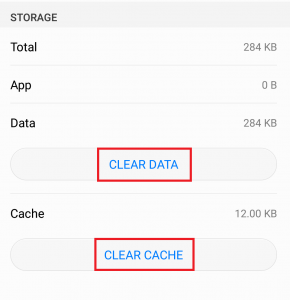
- This should ensure you won’t have an actively running Samsung Pay again, but it will still be present on your system and will use a tiny amount of system resources.